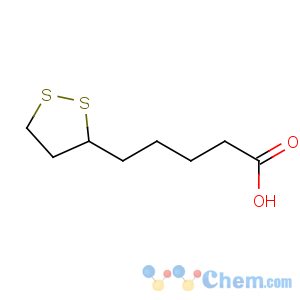alpha lipoic acid
-

Molecular Structure
Detailed Description
alpha lipoic acid
DL-Thioctic acid
Synonyms:(+-)-2-dithiolane-3-pentanoicacid;(+-)-2-dithiolane-3-valericacid;(+/-)-2-dithiolane-3-pentanoicacid;1,2-Dithiolane-3-pentanoicacid,(+-)-(9CI);2-Dithiolane-3-valericacid,(+-)-1
CAS:1077-28-7
MF:C8H14O2S2
MW:206.33
EINECS:214-071-2
Assay (HPLC) >99.0%
Density: 160
Melting point: 60-63
Boiling point: 160-165
Description: Slightly yellow crystal powder
Usage A fat-metabolism stimulator
Package: 25kg/drum
Storage: Refrigerate in a dry place.
Shelf life: 4 years when properly stored.
Effects & Applications
1) ALA is a good antioxidant. Taken internally, it is a water and fat soluble antioxidant that is capable of regenerating other antioxidants, such as vitamins C and E;; it also can help prevent cellular damage via its antioxidant properties.
Usually it is used for diabetes, peripheral neuropathy, cardiac autonomic neuropathy, retinopathy, cataracts, and glaucoma. Alpha-lipoic acid is also used orally for dementia, chronic fatigue syndrome , HIV/AIDS, cancer, liver disease, cardiovascular disease, peripheral arterial disease, intermittent claudication, Lyme disease, and lactic acidosis caused by inborn errors of metabolism.
2) It also has anti-inflammatory effects
3) Topically, alpha-lipoic acid is used to reduce facial wrinkles, lines, and sun damage.
but it is extremely vulnerable to degradation by sunlight, and 5% or higher alpha lipoic acid are capable of causing burning or stinging sensations or a mild rash on skin.
Items Specification Results
Appearance Light yellow crystalline powder Complies
Identification IR Meets the requirement
Melting point 60.0~62.0?? 61.2~62.0??
Loss on Drying ≤0.2% 0.09%
Residue on ignition ≤0.1% 0.08%
Polymer content ≤2% Complies
Related substance(HPLC) 6,8-Epitrithiooctanoicacid Single unknown impurity Total unknown impurity ≤0.2% ≤0.2% ≤0.5 Non detectable 0.09% 0.37%
Residue solvents(GC) toluene Ethyl Acetate Cyclohexane ≤ 30ppm ≤ 250ppm ≤ 1000ppm Conforms Conforms Conforms
Conclusion Qualified with corporate standard
alpha lipoic acid
DL-Thioctic acid
Synonyms:(+-)-2-dithiolane-3-pentanoicacid;(+-)-2-dithiolane-3-valericacid;(+/-)-2-dithiolane-3-pentanoicacid;1,2-Dithiolane-3-pentanoicacid,(+-)-(9CI);2-Dithiolane-3-valericacid,(+-)-1
CAS:1077-28-7
MF:C8H14O2S2
MW:206.33
EINECS:214-071-2
Assay (HPLC) >99.0%
Density: 160
Melting point: 60-63
Boiling point: 160-165
Description: Slightly yellow crystal powder
Usage A fat-metabolism stimulator
Package: 25kg/drum
Storage: Refrigerate in a dry place.
Shelf life: 4 years when properly stored.
Effects & Applications
1) ALA is a good antioxidant. Taken internally, it is a water and fat soluble antioxidant that is capable of regenerating other antioxidants, such as vitamins C and E;; it also can help prevent cellular damage via its antioxidant properties.
Usually it is used for diabetes, peripheral neuropathy, cardiac autonomic neuropathy, retinopathy, cataracts, and glaucoma. Alpha-lipoic acid is also used orally for dementia, chronic fatigue syndrome , HIV/AIDS, cancer, liver disease, cardiovascular disease, peripheral arterial disease, intermittent claudication, Lyme disease, and lactic acidosis caused by inborn errors of metabolism.
2) It also has anti-inflammatory effects
3) Topically, alpha-lipoic acid is used to reduce facial wrinkles, lines, and sun damage.
but it is extremely vulnerable to degradation by sunlight, and 5% or higher alpha lipoic acid are capable of causing burning or stinging sensations or a mild rash on skin.
Items Specification Results
Appearance Light yellow crystalline powder Complies
Identification IR Meets the requirement
Melting point 60.0~62.0?? 61.2~62.0??
Loss on Drying ≤0.2% 0.09%
Residue on ignition ≤0.1% 0.08%
Polymer content ≤2% Complies
Related substance(HPLC) 6,8-Epitrithiooctanoicacid Single unknown impurity Total unknown impurity ≤0.2% ≤0.2% ≤0.5 Non detectable 0.09% 0.37%
Residue solvents(GC) toluene Ethyl Acetate Cyclohexane ≤ 30ppm ≤ 250ppm ≤ 1000ppm Conforms Conforms Conforms
Conclusion Qualified with corporate standard
Ethisterone CAS : 434-03-7
Norethisterone CAS:68-22-4
Ethynyl estradiol CAS:57-63-6
Ethynodiol diacetate CAS:297-76-7
Chlormadinone acetate CAS.: 302-22-7
Cyproterone acetate CAS.: 427-51-0
Megestrol acetate CAS.: 595-33-5
Estradiol CAS:50-28-2
17alpha-Oestradiol CAS: 57-91-0
Estradiol Cypionate CAS:313-06-4
Estradiol enantate CAS: 4956-37-0
Estradiol valerate CAS: 979-32-8
Estradiol Benzoatae CAS:50-50-0
Estrone CAS: 53-16-7
Estriol CAS: 50-27-1
19-Norethindrone acetate CAS:51-98-9
Norethisterone enanthate CAS:3836-23-5
Testolactone CAS:968-93-4
Eplerenone CAS: 107724-20-9
Progesterone CAS:57-83-0
Medroxyprogesterone Acetate CAS: 71-58-9

- alpha lipoic acid




